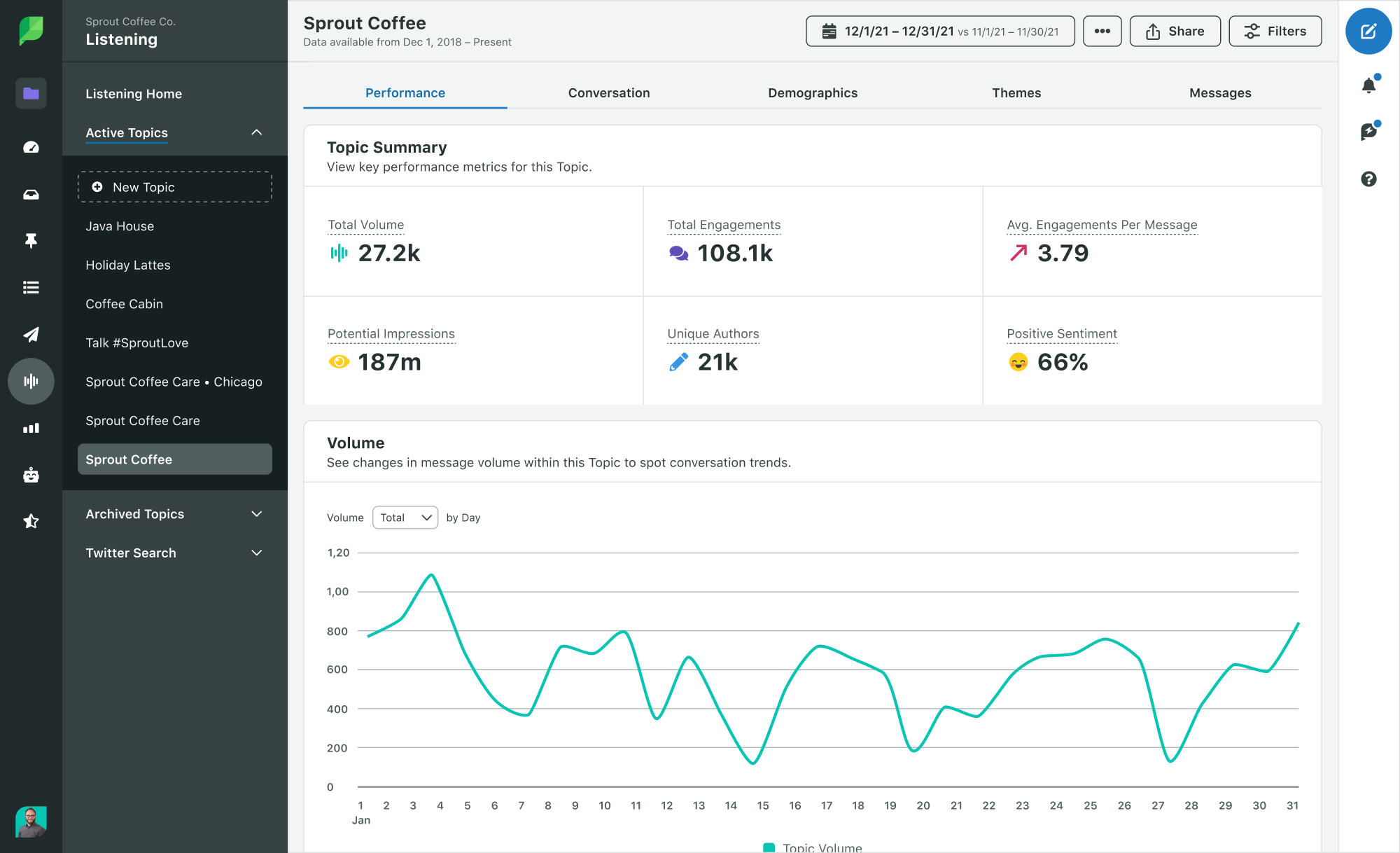LinkedIn SEO: 7 tips to optimize your company page
Brands love using LinkedIn for business. It’s one of the best platforms for expanding your professional network, connecting with customers and hiring top talent.
But with over 67 million companies listed on LinkedIn, it’s more competitive than ever for businesses to stand out on the platform. The fix? A solid LinkedIn SEO strategy.
Social search is growing. And as more LinkedIn pages quietly make their way to the top of Google search results, there’s a clear need for brands to optimize their profiles for maximum visibility both on and off the platform.
Below, we’ll share expert tips and insights to help you improve LinkedIn SEO and drive more reach and engagement on your posts. We’ll also discuss the various factors LinkedIn’s algorithm takes into account when ranking company pages.
- What is LinkedIn SEO?
- Importance of LinkedIn SEO for brands
- LinkedIn SEO ranking factors
- 7 LinkedIn SEO tips for company pages
What is LinkedIn SEO?
LinkedIn SEO is the practice of optimizing your business page and content to rank higher in LinkedIn’s native search results. Just like traditional SEO, it involves using the right keywords, creating great content and building a strong presence on the platform.
The goal is to make it easier for potential clients, partners and followers to find you. The benefits are substantial. More traffic, targeted leads and higher credibility to name a few.
But LinkedIn SEO is now more than just a platform-specific strategy. With Google ranking an increasing number of LinkedIn pages in its search results, brands need to approach SEO for LinkedIn from a more holistic point of view.
Importance of LinkedIn SEO for brands
Before we get into the ranking factors and tips, let’s talk about why LinkedIn SEO matters for your business. Here are some benefits of optimizing for search on the platform:
Drive traffic and leads to your page
Having a LinkedIn company page is pointless if no one visits it. Using SEO tactics like keyword optimization and sharing relevant content pushes you higher up in LinkedIn search results. This naturally drives more clicks and views on your page.
More importantly, SEO for LinkedIn drives targeted leads to your page—potential customers actively searching for solutions, partners looking to collaborate or job seekers hunting for opportunities in your industry.
Increase brand awareness
LinkedIn SEO is a powerful tool to boost brand recognition and keep your company top of mind. By ranking higher in searches and appearing more frequently in user feeds, you’re essentially putting your brand on a virtual billboard for all to see.
The more people lay eyes on your company name and content, the more likely they are to remember you when they need your products or services.
Build trust and authority
When your company consistently posts quality content and ranks high in search for relevant keywords, it sends a strong signal to potential customers that you know your stuff.
They’ll view your brand as a credible source of information and expertise, which can heavily influence their decision to choose you over competitors.
Attract qualified talent
LinkedIn is not just about networking and generating leads. It’s also the go-to platform for talent looking for career opportunities that align with their skills, location and preferences.
Optimizing for search allows potential hires to find your company and job postings easily. Sharing compelling content about your company’s culture and values also helps you stand out as an employer and draw in more qualified candidates.
LinkedIn SEO ranking factors
Before you start optimizing for visibility on LinkedIn, you need to understand how the algorithm works. In this section, we’ll discuss the different factors LinkedIn’s algorithm considers when ranking content in search or user feeds.
Keyword optimization
The keywords you use across your company page play a big role in how well you rank in LinkedIn searches. The algorithm analyzes the presence and frequency of relevant keywords in your tagline, About section, services, posts, articles, hashtags and other places.
Conduct keyword research to identify relevant terms your target audience is searching for. Then, strategically place these keywords into your page info, posts and articles to improve your search visibility both on and off LinkedIn.
Beware of keyword stuffing. It can negatively impact your rankings and make your company look like spam. Not to mention, if people don’t trust your business page, they’re less likely to view or click on it, which reduces your overall credibility and reach.
Business profile information
LinkedIn’s search algorithm prioritizes company profiles that are complete with all business details. In fact, companies with complete information get 30% more weekly views on average.
Include your business locations, size, industry, specialities, website URL, workplace module and commitments. The algorithm also looks at sections like featured and About, so add keyword-rich descriptions and make sure no field is empty or incomplete.
Take a look at Sprout Social’s LinkedIn page for an example of a complete profile.

Completing your LinkedIn page helps users find your company easily as well as understand who you are and what you do. It also makes you look professional and builds credibility.
Engagement
The level of engagement your content receives heavily influences your search rankings on LinkedIn. According to the platform, the algorithm evaluates both the quantity and quality of interactions on your posts, comments and reactions.
Pages that consistently generate a high volume of discussions and comments, as well as those with thoughtful and relevant interactions, are more likely to rank well in search.
Regular activity and updates
LinkedIn’s algorithm takes into account how current your profile information is and how frequently you post updates, such as about any new products, services or job openings.
Fresh content is also more likely to get indexed by Google, expanding your reach to audiences searching for solutions and keywords outside of LinkedIn.
Engaging with other users’ posts by liking, commenting and sharing also shows the algorithm that you’re an active and valuable member of the LinkedIn community. Doing so is not just good for SEO, but it also keeps you on top of user feeds.
Strong network of followers
Got zero to few followers? Yes, you should be concerned as the size and quality of your LinkedIn network can impact your search rankings. LinkedIn says its algorithm considers:
- The number of followers your company page
- The number of connections searchers have with your page
A larger and more engaged network with members from your industry can help you show up in front of potential clients, partners and job seekers. It’s also a good indicator of your company’s influence and authority in its niche.
7 LinkedIn SEO tips for Company Pages
You know what the LinkedIn algorithm wants. But how do you leverage those factors to work in your brand’s favor? How do you ensure your content gets maximum exposure and your page gets pushed to the top of search results?
Follow the tips below to improve LinkedIn search rankings for your company page.
1. Run employee advocacy programs
Here’s a not-so-secret hack to kickstart engagement on LinkedIn: turn to your employees! Jumpstart an employee advocacy program. Encourage them to follow your page, interact with your content, tag you in their posts and spread positive word about your brand.
The more follows, tags, mentions, recommendations and endorsements you get, the more the algorithm will recognize your page as popular and trustworthy. Ultimately, employee advocacy will help your page and content rank higher in search.

Source: LinkedIn
Not to mention, your employees have their own professional networks you can piggyback on to expand your reach. In fact, you should encourage them to strengthen their profiles and personal brands. When strong LinkedIn profiles are connected to your company page, you’ll see a significant boost in LinkedIn search rankings and overall credibility.
You can streamline this process by providing employees with pre-written posts or suggestions for engagement. For example, give them branded hashtags to use in their posts. Or share behind-the-scenes event photos and videos they can post on their own profiles.
Sprout Social’s employee advocacy features make it easier for people across your organization to share pre-approved brand content on LinkedIn with a few clicks. Watch the video below to see what’s possible with employee advocacy.
Finally, reward employees who advocate your brand on LinkedIn. This will motivate them to engage more frequently and regularly. Host LinkedIn challenges or competitions to encourage employees to up their game and get creative with post ideas.
2. Stick to a consistent posting schedule
When you post regularly, it signals to the algorithm your page is active. This is great news for your LinkedIn SEO goals.
Create a content calendar and commit to posting consistently on a schedule that works for your business. This could be daily, a few times a week or a few times a month.
Use LinkedIn’s native scheduling feature or a third-party tool to plan your posts in advance. Sprout Social, for example, can help you draft, target and schedule LinkedIn posts easily.

We recommend considering the best times to post on LinkedIn when you schedule your posts. But it’s important to use that as a starting point. As you analyze your post performance data over time, you will want to prioritize the times your audience is uniquely engaged the most over what generally works on the platform.
3. Use data to guide your strategy
The best LinkedIn SEO strategies are data-driven. Here are some ways you can use LinkedIn analytics to improve visibility and engagement on the platform:
- Narrow down your target audience: LinkedIn has over 1 billion members, but not everyone is going to be a potential buyer or partner. Identify your audience’s demographics, interests and other characteristics to create targeted posts that truly resonate with your audience. One way to set yourself up for success in this is by conducting research through surveys and interviews. Or you can use existing audience data from a LinkedIn analytics tool.
- Plan content around trending keywords: Dig into search data and practice social listening to find popular keywords and topics on LinkedIn. Create posts, articles, carousels and more surrounding those keywords to join the conversation. This can boost the reach and engagement of your content.

- Analyze and optimize post performance: Track post metrics like engagement and impressions to gauge how well your strategy is working and what could be improved. Which topics are getting the most traction? Does your audience interact more with images or text-only posts? Use these insights to optimize future posts.
4. Share a variety of content formats
LinkedIn offers several different content types for a reason. Weave carousels, polls, long-form posts, short posts, articles, images, videos, live events and PDFs into your content calendar.
At Sprout, we switch things up regularly and even repost user-generated content on our LinkedIn page.

It’s best practice for LinkedIn SEO to share a mix of educational, promotional and entertaining content that aligns with your brand. Stay updated with new features and trending formats to engage your audience in unique ways and position your brand as innovative and interesting.
And, don’t be afraid to show some personality. It makes your brand feel more authentic and helps you stand out from the competition. And remember, not every content format is going to work for your business and audience. But you won’t know until you try, so keep experimenting and use data to guide your strategy.
5. Build backlinks from external sites
The more backlinks you build from strong domains, the more clicks, views and “link juice” you’ll get, and the more likely your page is to rank higher in both LinkedIn and Google searches.
Start by publishing high-quality articles and posts on LinkedIn that people would want to link out to as a resource from external sites. Link back to your LinkedIn page from email signatures, guest blogs, webinars, podcasts and other social networks to boost engagement on your LinkedIn posts.
Another best practice is to add a social button at the bottom of pages or embed links in your content. This can encourage people to visit or follow your LinkedIn page from your blog or website as well.
6. Add relevant hashtags to your posts
LinkedIn hashtags are a powerful way to drive visibility and growth on the platform. They help your content become part of trending conversations and reach people with specific interests.
Research popular and niche hashtags in your industry, and incorporate them naturally into your posts and articles. Use a mix of branded, industry-specific and trending hashtags to reach a wider audience.
Be sure to use hashtags that are relevant to your content and target audience. Avoid using too many hashtags in a single post, as this can come across as spammy. We recommend using around 3-5 hashtags per post, like Canva does here:

Source: LinkedIn
7. Participate in groups and discussions
LinkedIn is all about networking and community-building. Engaging in LinkedIn groups and conversations helps you generate brand awareness, build relationships, demonstrate your expertise and drive traffic to your company page.

Source: LinkedIn
Join groups that are relevant to your brand or industry. Engage by asking questions, share insights, provide resources and contribute to discussions. When you consistently bring value to the table, people are more likely to notice you, engage with your content and check out your company page.
Another way to get your voice out there is to contribute to collaborative articles on LinkedIn. These are crowdsourced pieces on specific topics developed by AI and LinkedIn’s editorial team.

Source: LinkedIn
Members can add their own insights, perspectives and examples to different sections in the articles. This is an excellent way to show your expertise, build thought leadership and get more visibility on your company page.

Source: LinkedIn
Use LinkedIn SEO to improve brand visibility
LinkedIn is a platform marketers cannot ignore. A solid LinkedIn SEO strategy can help your brand stand out from the competition and show up in front of the right people.
Understanding how LinkedIn’s algorithm works can help you improve your rankings. Optimize for relevant keywords, complete your profile, stay active, engage in groups and conversations, use hashtags and experiment with different content types to boost visibility.
Looking for more help? Here’s a list of LinkedIn marketing tools to help you grow and succeed on the platform.
The post LinkedIn SEO: 7 tips to optimize your company page appeared first on Sprout Social.






